| Kursk: Burning Tigers
The Storm Panzer
By Mike Bennighof, Ph.D.
May 2023
 The German Operation Citadel, the July 1943 offensive at Kursk, would feature a number of well-known new weapons. The Panther and Tiger tanks, huge Ferdinand (later re-named Elefant) tank destroyers and the tiny, toy-like Goliath demolition tanks. The German Operation Citadel, the July 1943 offensive at Kursk, would feature a number of well-known new weapons. The Panther and Tiger tanks, huge Ferdinand (later re-named Elefant) tank destroyers and the tiny, toy-like Goliath demolition tanks.
Against those wonder weapons, the Sturmpanzer IV seems almost an afterthought. The project began in October 1942 with an emergency order for an assault gun to be deployed in the streets of Stalingrad, able to demolish a building with just one or two shots. The 75mm short-barreled guns of existing assault guns lacked the needed explosive power, which could be supplied by the 150mm infantry gun already deployed on open-topped self-propelled mounts. But for the Stalingrad fighting, a fully-enclosed version would be needed.

A Storm Panzer and its crew, somewhere in Italy.
Alkett (Altmärkische Kettenwerk), which manufactured most German assault guns and many tanks, took on the project using the chassis of damaged Sturmgeschütz III assault guns. Alkett’s chief designer, Paul Michaels, drafted a box-like armored superstructure to house a 150mm infantry gun. Alkett delivered the first six vehicles within 15 days, and a total of 12 in October and 12 more in November 1942. This Sturm-Infanteriegeschütz 33B had an armored roof, since it would be used in urban combat, and only very limited (25-degree) elevation for its gun. All of the first dozen were lost in the Stalingrad fighting within a few weeks, and all of the second lot by October 1943.
Michaels continued design work for an improved version based on the Panzer IV chassis, which he thought would better bear the weight of the 150mm gun and the improved armor he wished to give the vehicle. The new version had sloped armor over a fully-enclosed fighting compartment, with very thick (100mm) frontal protection.
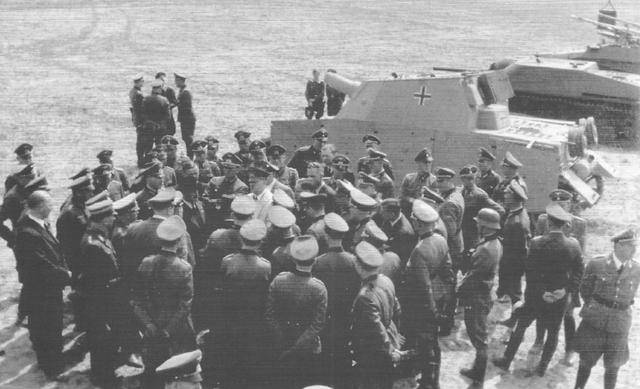
The Supreme Leader inspects the Storm Panzer prototype.
Alkett showed Michaels’ drafts to Adolf Hitler on 14 October 1942, who gave his approval for further development – as in the Soviet Union, the Supreme Leader micro-managed tank design. A wooden mockup was ready by February 1943, again gaining approval and causing Heinz Guderian, Chief Inspector of Armored Troops, to pay a visit to Hitler to discuss Alkett’s design. Guderian convinced the Supreme Leader to change its name from “assault gun” to “assault tank,” which meant it would be controlled by the armored branch and not the artillery.
That bureaucratic victory gave the new tank (as it had become by the stroke of Hitler’s pen) the official designation of Sturmpanzer IV. The Storm Panzer received a production order for 40 units to be delivered by 12 May, soon raised to sixty vehicles.
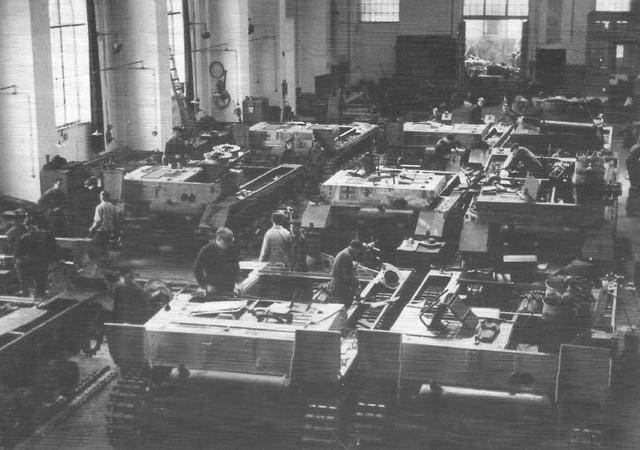
Assembling Storm Panzers in the Vienna Arsenal.
Production moved to the Heeres-Kraftfahrzeug-Werkstatt in the Vienna Arsenal, a repair facility for damaged Panzer IV medium tanks. Chassis would be converted there into Storm Panzers, and the workers used those of several different models (E, F and G) to assemble the new tank. Additional armor was bolted onto the tanks’ front plate of earlier-model chassis; when production shifted to newly-built hulls this was no longer necessary. The armored bodies came from other Austrian firms, Oberdonau and Böhler, with Saurer, another Austrian company, serving as project manager.
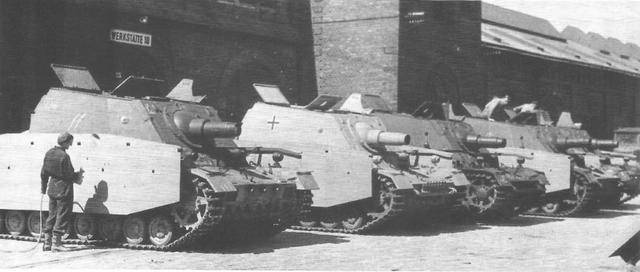
Painting the first batch of Storm Panzers.
The consortium met their delivery deadlines, handing over 40 Storm Panzers in April and 20 more in May 1943. All of the first lot and a handful of the second made it to the front in time to participate in the July Kursk offensive. They all served with the 216th Heavy Tank Detachment, which fought as part of the 656th Anti-Tank Detachment. Sources vary, giving the detachment either three companies of 14 Storm Panzers each or two with 23 and 22, respectively.
Not all of those were Storm Panzers. The Vienna Arsenal had several chassis of the old Panzer IV Model D, with armor too thin to be brought up to standard with additional plates. These became ammunition carriers, with the turret removed and most of the fighting compartment given over to shell stowage. Six of them were completed and shipped to the assembly area in Orel along with the first forty Storm Panzers.

The ammunition carrier version.
The Storm Panzer had thick armor – 100mm on its front and 50mm on its sides – and of course the relatively enormous 150mm gun. It also carried a single machine gun; in these first models it went in an open mount atop the superstructure. In theory it could match the speed of the Panzer IV tank, but it weighed in three tons heavier than the tank and the overloaded Storm Panzer could not make its designed speed in practice.
The 150mm ammunition came in two pieces, and handling its weight (38 kilograms, or 84 pounds, for the high-explosive round and another eight kilograms for its propellant cartridge) proved very difficult for the crew, especially in the close quarters of the fighting compartment. These were very large rounds, and the Storm Panzer could only accommodate 38 of them, making the armored ammunition carriers a very useful addition.
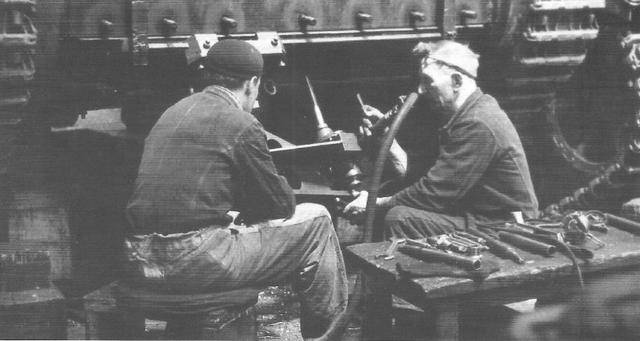
Arsenal workers add armor to a Storm Panzer chassis.
The Storm Panzers made their combat debut alongside the 292nd and 86th Infantry Divisions in the bitter fighting for Ponyri Station on the northern flank of the Kursk offensive. While the German offensive failed, the Storm Panzers received good reviews from the troops. They shrugged off hits from Soviet 76.2mm field guns deployed in the anti-tank role, and had the firepower to smash field fortifications and buildings alike.
But the crews also criticized the weight of the gun and armor, and the difficulties of handling the massive 150mm rounds. The Storm Panzer had by necessity followed the layout of the Panzer IV, with the engine mounted in the rear and the fighting compartment in the front. That made it front-heavy and difficult to steer; since the gun had very limited traverse, it had to be aimed by pointing the entire vehicle at the target, making this more than a minor difficulty. And the crews most definitely disliked having to expose themselves to enemy fire in order to operate the machine gun.
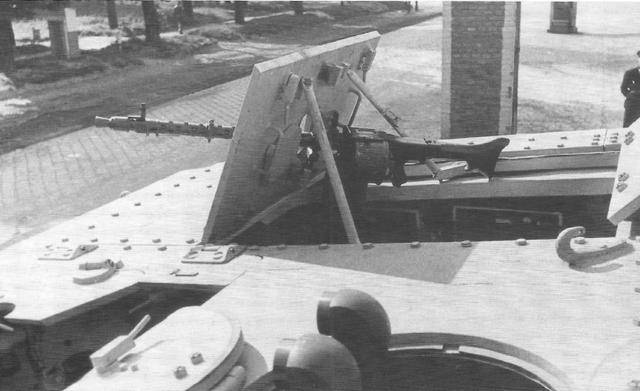
The machine-gun mount of the early Storm Panzers.
Even so, the Army Weapons Office placed a new production order for 80 more Storm Panzers in November 1943. The Vienna Arsenal immediately ran into problems trying to fill the order and could only deliver four more in November. Panzer division commanders had sent their badly damaged Panzer IV tanks to the Arsenal for major repairs or overhaul, expecting to get them back. Instead, their tanks had been turned into Storm Panzers and the various front-line battalions were now short 60 Panzer IV tanks.
Instead, the nearby Nibelungenwerke in St. Valentin, the huge factory complex that produced the Panzer IV, would provide brand-new Model H chassis for conversion. That pause gave chief designer Michaels a chance to incorporate the lessons of Ponyri Station into a revised model.

A Storm Panzer shows off its ammunition stowage.
Much of the trouble, he realized, came from damage inflicted on the suspension by the recoil of the 150mm gun. So while he strengthened the suspension, he also replaced the main armament. Skoda, the Czech firm now under the control of Hermann Goering’s younger brother, had developed a ball mount for the 150mm infantry gun for use in a proposed version of its Grille self-propelled mount, and Michaels adopted this weapon for the improved vehicle. The new weapon fired the same ammunition as the infantry gun, making the transition fairly easy. Michaels also moved the machine gun to a fully-protected ball mount on the upper right corner of the fighting compartment.
The Weapons Office wanted 20 new Storm Panzers delivered per month, a target later raised to 30. That was far beyond what the Vienna Arsenal could construct, and production moved to Deutsche Eisenwerke in Duisburg in June 1944.
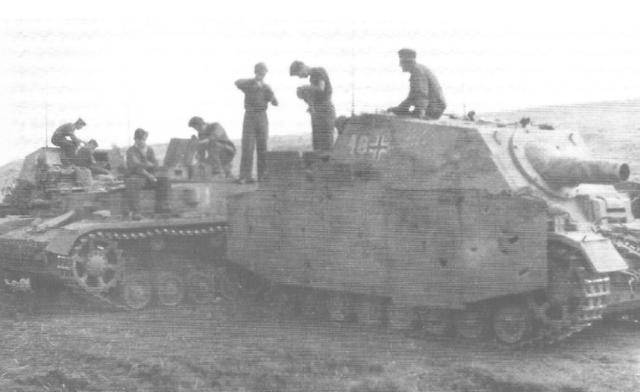
Reloading two Storm Panzers from an armored ammunition carrier.
In all, 302 Storm Panzers would be delivered to the German Army (none went to the Armed SS militia, though the Hitler Youth Division ended up with ten of them transferred from an Army unit). Four battalions saw action: the 216th at Kursk and in Italy, the 217th on the Western Front, the 218th in Poland and East Prussia and the 219th in Hungary. The plethora of German vehicle types limited overall armored vehicle production, but the Storm Panzer appears to have been an actually useful conversion.
An American intelligence report from June 1944 called the Storm Panzer the “Brummbär,” which it mis-translated as “Grizzly Bear” (more accurately it would be “Grouch”). The Germans never used this name; it was always the Storm Panzer, sometimes shortened to Stupa.
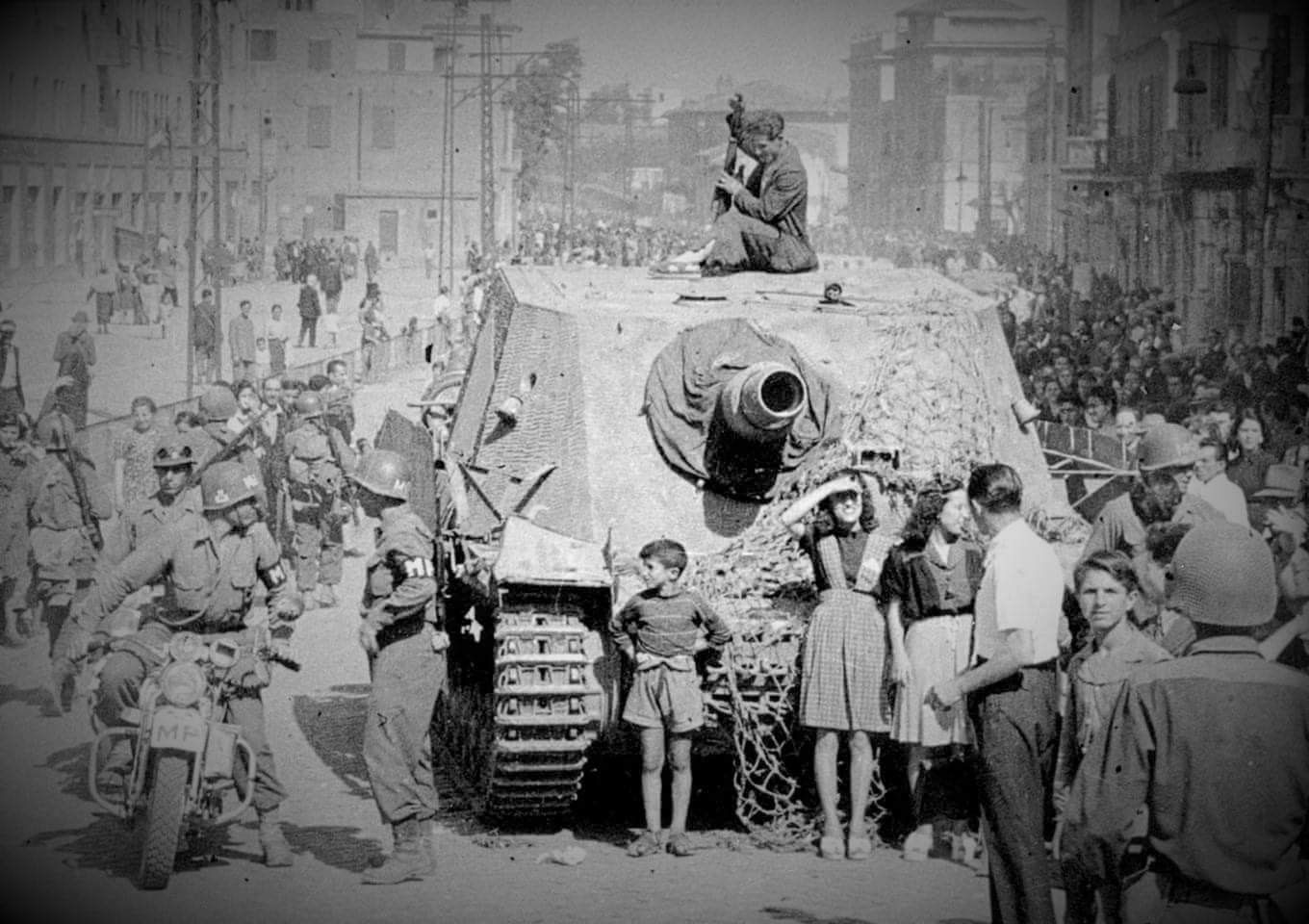
This Storm Panzer was abandoned in Rome.
The Storm Panzer sees action in Kursk: Burning Tigers.
You can order Burning Tigers (Playbook edition) right here.
Please allow an extra three weeks for delivery.
Sign up for our newsletter right here. Your info will never be sold or transferred; we'll just use it to update you on new games and new offers.
Mike Bennighof is president of Avalanche Press and holds a doctorate in history from Emory University. A Fulbright Scholar and NASA Journalist in Space finalist, he has published a great many books, games and articles on historical subjects; people are saying that some of them are actually good.
He lives in Birmingham, Alabama with his wife, three children, and new puppy. He misses his lizard-hunting Iron Dog, Leopold.
Want to keep Daily Content free of third-party ads? You can send us some love (and cash) through this link right here.
|
